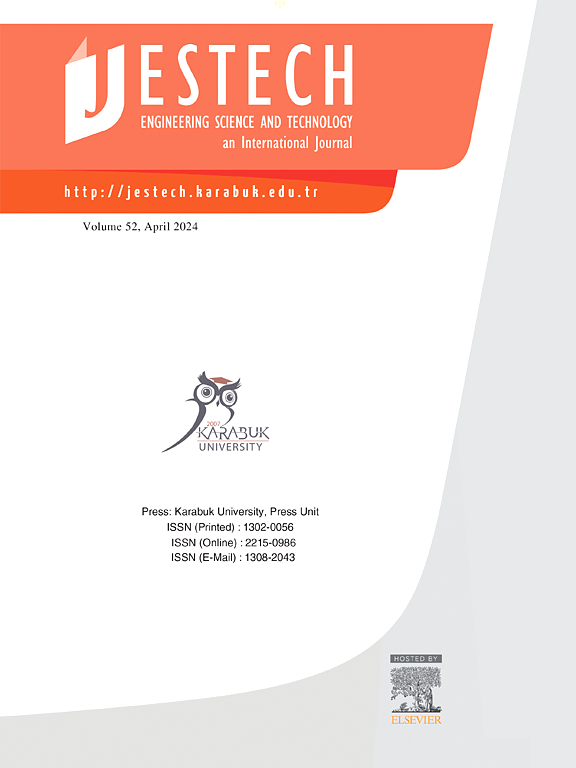Transfer learning based hybrid feature learning framework for enhanced skin cancer diagnosis using deep feature integration
IF 5.4
2区 工程技术
Q1 ENGINEERING, MULTIDISCIPLINARY
Engineering Science and Technology-An International Journal-Jestech
Pub Date : 2025-07-09
DOI:10.1016/j.jestch.2025.102135
引用次数: 0
Abstract
Skin cancer continues to be a major health problem worldwide, with excessive misdiagnosis of skin cancer among dermatologists resulting in delayed treatment and poor patient outcomes. To improve survival chances, skin cancer must be identified accurately and promptly. However, current diagnostic methods lack feature representation and model generalization. Among the primary challenges in automated skin cancer classification are addressing differences in lesion appearance, occlusions, and data class imbalance that impact model performance and reliability. To address these issues, this research proposes the DRMv2Net model, a feature fusion deep learning-based technique that integrates multiple pre-trained convolutional neural networks to enhance skin cancer diagnosis. The method applies a systematic pipeline that includes pre-processing, feature extraction, fusion, and classification. The pre-processing techniques such as adaptive thresholding for hair artifact removal, image inpainting to remove occlusions, and data augmentation for class balancing, were applied to enhance the quality of inputs. Using DenseNet201, ResNet101, and MobileNetV2, diverse features like edges, texture, and color change were extracted and concatenated to build a rich feature representation, followed by fully connected layers for classification. The two benchmark datasets, ISIC 2357 and PAD-UFES 20, are used extensively in testing the DRMv2Net model. A comparison with standalone CNN models such as DenseNet201, ResNet101, MobileNetV2, VGG19, and Xception shows that feature fusion had better accuracy results of 96.11 % on ISIC 2357 and 96.17 % on PAD-UFES 20 respectively when compared to values obtained by existing standalone models. These results demonstrate the strength of feature fusion and pre-processing in boosting how accurately skin cancer is identified and offer a robust and scalable automatic medical image classification solution.
基于深度特征集成的迁移学习混合特征学习框架增强皮肤癌诊断
皮肤癌仍然是世界范围内的一个主要健康问题,皮肤科医生对皮肤癌的过度误诊导致治疗延误和患者预后不良。为了提高生存机会,必须准确及时地识别皮肤癌。然而,目前的诊断方法缺乏特征表示和模型泛化。自动化皮肤癌分类的主要挑战之一是处理影响模型性能和可靠性的病变外观、闭塞和数据类别不平衡的差异。为了解决这些问题,本研究提出了DRMv2Net模型,这是一种基于特征融合深度学习的技术,集成了多个预训练的卷积神经网络来增强皮肤癌诊断。该方法采用了一个系统的流水线,包括预处理、特征提取、融合和分类。预处理技术,如自适应阈值去除毛发伪影,图像上漆去除遮挡,和数据增强类平衡,应用于提高输入的质量。使用DenseNet201, ResNet101和MobileNetV2,提取并连接边缘,纹理和颜色变化等多种特征,构建丰富的特征表示,然后使用完全连接的层进行分类。两个基准数据集ISIC 2357和pad - ues 20被广泛用于测试DRMv2Net模型。对比DenseNet201、ResNet101、MobileNetV2、VGG19、Xception等独立CNN模型,与现有独立模型相比,ISIC 2357和pad - ues 20上的特征融合准确率分别达到96.11%和96.17%。这些结果证明了特征融合和预处理在提高皮肤癌识别准确性方面的优势,并提供了一个鲁棒性和可扩展的自动医学图像分类解决方案。
本文章由计算机程序翻译,如有差异,请以英文原文为准。
求助全文
约1分钟内获得全文
求助全文
来源期刊

Engineering Science and Technology-An International Journal-Jestech
Materials Science-Electronic, Optical and Magnetic Materials
CiteScore
11.20
自引率
3.50%
发文量
153
审稿时长
22 days
期刊介绍:
Engineering Science and Technology, an International Journal (JESTECH) (formerly Technology), a peer-reviewed quarterly engineering journal, publishes both theoretical and experimental high quality papers of permanent interest, not previously published in journals, in the field of engineering and applied science which aims to promote the theory and practice of technology and engineering. In addition to peer-reviewed original research papers, the Editorial Board welcomes original research reports, state-of-the-art reviews and communications in the broadly defined field of engineering science and technology.
The scope of JESTECH includes a wide spectrum of subjects including:
-Electrical/Electronics and Computer Engineering (Biomedical Engineering and Instrumentation; Coding, Cryptography, and Information Protection; Communications, Networks, Mobile Computing and Distributed Systems; Compilers and Operating Systems; Computer Architecture, Parallel Processing, and Dependability; Computer Vision and Robotics; Control Theory; Electromagnetic Waves, Microwave Techniques and Antennas; Embedded Systems; Integrated Circuits, VLSI Design, Testing, and CAD; Microelectromechanical Systems; Microelectronics, and Electronic Devices and Circuits; Power, Energy and Energy Conversion Systems; Signal, Image, and Speech Processing)
-Mechanical and Civil Engineering (Automotive Technologies; Biomechanics; Construction Materials; Design and Manufacturing; Dynamics and Control; Energy Generation, Utilization, Conversion, and Storage; Fluid Mechanics and Hydraulics; Heat and Mass Transfer; Micro-Nano Sciences; Renewable and Sustainable Energy Technologies; Robotics and Mechatronics; Solid Mechanics and Structure; Thermal Sciences)
-Metallurgical and Materials Engineering (Advanced Materials Science; Biomaterials; Ceramic and Inorgnanic Materials; Electronic-Magnetic Materials; Energy and Environment; Materials Characterizastion; Metallurgy; Polymers and Nanocomposites)
 求助内容:
求助内容: 应助结果提醒方式:
应助结果提醒方式:


